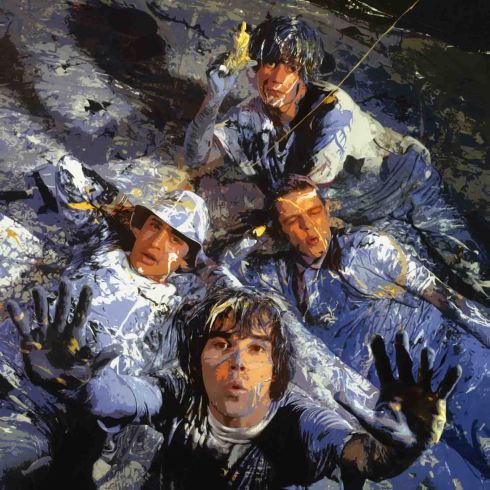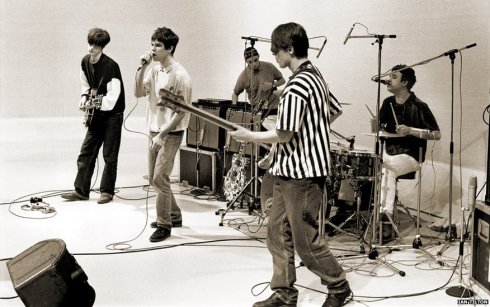If there’s one band after the 1960s that captured the spirit of optimism and good times to be had, than it’s The Stone Roses whose debut album was treated as a ‘Holy Bible‘ by a generation of British rockers.
 Cover of their debut album ‘The Stone Roses’ (1989)
Cover of their debut album ‘The Stone Roses’ (1989)
‘Kiss me where the sun don’t shine/The past was yours/But the future’s mine/You’re all out of time‘ (She bangs the drums); even before they gained their widespread fanatical following The Stone Roses were assured in their ‘role of saviors‘. This modest philosophy is evident in many 0f their songs from the debut album, in verses such as ‘I don’t need to sell my soul/He’s already in me/I wanna be adored‘ and ‘My aim is true/My message is clear‘ (Elizabeth my dear). Indeed, The Stone Roses gained a cult of followers despite having released only two albums, and paved the way for a new generation of Indie rock musicians, encouraging them to delve into the 1960s Psychedelia. Still, their success and self confidence brought a mass phenomenon of immense arrogance of some British bands who tend to behave like gods after only a few singles.
British music scene saw a decline in the 1980s. A nation that gave music so many legends (The Beatles, The Rolling Stones, The Who, Kinks, Pink Floyd, The Sex Pistols, The Clash etc.) was in the shadow of American bands. The Smiths were there, providing a glimpse of light and hope in desperate times, but they split in 1987. Embittered and clueless, British music scene was in desperate need of someone who’d come up with a vision of salvation. The desperately awaited Resurrection came in a form of The Stone Roses. The new era of Manchester music was just beginning; Madchester was born.

The Stone Roses (Ian Brown – vocals, John Squire – lead guitar, Mani – bass guitar, and Reni – drums) were part of a new wave of Manchester bands who’d give indie music a psychedelic twist. Their early sound captured that west coast psychedelia, a sense of The Byrds. Front man Ian Brown walked on the stage with a Mancunian swagger, and, along with equally cocky and cheeky musicians, he led the way on the Madchester scene. They believed they were born to do it, and that’s what they did. With their debut album of the same name, The Stone Roses gave indie music a completely fresh start.
‘1989 was the year the white kids woke up‘, said Ian Brown, and this can well and truly be applied to the Manchester scene at the time. Manchester’s bleak and gloomy image, based partly on the cold climate of north England, and over yet on the legacy of post-punk legends of Joy Division, was transformed in 1989. Rave houses such as Hacienda, along with the emerging new psychedelia bands, turned Manchester into Madchester, the mecca for the new generation of hedonists and 24 hour party people. Cheerful and hypnotic melodies from The Stone Roses’ debut album shone like a ray of sunshine over the once gloomy and industrial city of Manchester, now turned into a background for a never ending, optimism fueled Second summer of love.

Workaholic materialism of the ’80s faded, at least for a moment, and youth culture blossomed in the dawn of the 1990s. Ian Brown remembers ‘…a feeling of community strength … coming out of a club at the end of the night feeling like you were going to change the world. Then guns come in, and heroin starts being put in ecstasy. It took a lot of the love-vibe out.‘ The Stone Roses themselves detached from the club scene as the time progressed, but it the early days a spirit of psychedelia colourised the city’s drab legacy and turned it into a place to be. Idealism pervaded the air once again. For the young people whose mindsets were tuned with the ones of The Stone Roses, Manchester’s rainy days and gray landscapes turned into psychedelic swirls and paisleys, the sky was coloured with melodies from The Stone Roses’s debut album released in April/May 1989. For a moment, Manchester was a living dream.
The magnificent thing about this album is that it perfectly captures that free spirited atmosphere and could easily stand as a soundtrack to those fleeting times, but it’s unbelievably timeless. The quality of the album itself has never been debated by true artistic minds, and the NME named it the greatest British album ever in 2006. Clever mixture of psychedelic sounds and dance beats proved a lasting influence on rock music, and set the tone for the Indie music in the 1990s. Liam Gallagher bought the album four times, not only because the record wore out, but as a way of showing respect to a band that has influenced him so much.

As the time progressed, the album became even more critically acclaimed, gaining adjectives such as ‘godlike‘ (Melody Maker). However, the album’s popularity, which came almost over night, is not a coincidence. The Stone Roses owe credit to their success not only to the situation in UK at the time, but mainly to their artistic skills. Before venturing into their own playing, the band explored the 1960s music, wowing psychedelia of bands such as The Byrds into their own hypnotic guitar sounds.
On a visual level, The Stone Roses were influenced by Jackson Pollock in the same way they were influenced by The Byrds and ’60s psychedelia musically. Jackson Pollock, an American painter and a pioneer of Abstract-Expressionism, discarded the easel painting in favour of letting colour find its own way, spread freely and live a life of its own. He said ‘The modern artist is working with space and time, and expressing his feelings rather than illustrating.‘ The Stone Roses joyfully embraced Pollock’s philosophy in a way that they created a completely new ‘time and space‘, allowing their listeners to fall in a trance through their songs.
 Photo found here.
Photo found here.
Album The Stone Roses is a magnificent combination of the ’60s psychedelia and Pollock’s vision of expressing feelings through colours. Most of the songs from their debut album (‘Waterfall’, ‘Made of Stone’, ‘This Is The One’, ‘She Bangs the Drums’) start with a slight drumming and psychedelic lingering over the guitar strings, over which Ian’s hypnotic voice spreads like colour, only to end in an explosive guitar storm.
The album cover is a Pollock-inspired artwork by John Squire titled ‘Bye Bye Badman‘, which makes reference to May 1968 riots in Paris. Lemons gracing the cover are connected to the latter event as well. Squire said ‘Ian Brown had met this French man when he was hitching around Europe, this bloke had been in the riots, and he told Ian how lemons had been used as an antidote to tear gas. Then there was the documentary—-a great shot at the start of a guy throwing stones at the police. I really liked his attitude.‘ Even the covers of their singles are pastiches of Jackson Pollock’s work.

The summer of ’89 The Stone Roses began limiting themselves to spectacular gigs. First of these was the legendary concert at the Empress Ballroom in Blackpool’s Winter Gardens. Outside of Manchester the band had struggled to fill venues holding just a couple of hundred people. Concert at the Empress Ballroom was a gamble for it held a crowd of over 3000 people. Mani said that the band have always considered doing gigs like walking on tightrope; you could fall at any time but you enjoy the danger. The Stone Roses wanted to see how far they could go. On Saturday August 12th 1989 they held a headline gig at the Empress Ballroom to a crowd of 4000 people. The moment was there. The world was ready for The Stone Roses. ‘We’re anti-trivia above all else,’ Ian Brown said in 1989, and the band’s shimmering guitar sound along Ian’s hypnotic voice have surely colourised many boring trivialities.
Later that year, the band released their legendary single ‘Fools Gold‘; a ten minute epic that gives an impression that it could last ten hours and still wouldn’t become boring. In ten minutes it sums up all important events of rock ‘n’ roll; from blues and soul to acid house. Ian Brown said in December 1989 ‘We’re the most important group in the world, because we’ve got the best songs and we haven’t even begun to show our potential yet.‘ (NME) In May 1990 some 27,000 people attended The Stone Roses outdoor concert at Spike Island in Widnes. Although the sound and organisation were bad, the venues became legendary, often called ‘The second Woodstock’.
‘What the world is waiting for‘ were The Stone Roses. However, caught in a web of contractual wrangling, their fortunes took a downward turn. Although the Roses would never recapture their early magic, their legacy is still considerable.
For me, listening to The Stone Roses album is like dreaming a really magical, magnificent and purifying dream in which everything is possible. And after the last hypnotic reverberating sounds of the song ‘I am the resurrection‘ ends, and I wake up from that dream, Ian’s haunting voice singing ‘I wanna be adored…‘ resonates throughout my head the entire day, week, month, eternity…
I WANNA BE ADORED
‘I don’t have to sell my soul
He’s already in me
I don’t need to sell my soul
He’s already in me
I wanna be adored
I wanna be adored…‘
Tags: 1989, Alternative rock, Blackpool, British music scene, debut album, Empress Ballroom, goodreads, I wanna be adored, Ian Brown, Indie rock, John Squire, Madchester, Manchester, Mani, New Psychedelia, Reni, The Stone Roses




































